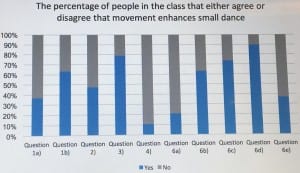We are nearing the end of our CI module and I was unable to join in due to an injury, however observing the class is just as impactful as joining in. Our main focus of this week’s lesson was using our pelvis’ to make contact with people; as a collective we have neglected this part of our bodies. The first exercise was connecting with partners by the pelvis using the bridge and kneeling position, during this investigation I noticed that many people did not investigate the whole range of movements available to them. The base is there to support but to also offer new ideas and ways of moving for the person being lifted.
Individual exploration started by either sitting or laying on the floor and focusing the mind to the task set and in their own time they had to move the body leading with the pelvis. They then had to move in and out of contact with the people in the room, still thinking about leading with the pelvis and creating contact with that neglected area of the body, when observing I noticed that the class need to work more as a collective and people need to give their weight more to others, I know everyone can do it, because we have all done the ‘1,2,3 fall’ exercise, which is giving your weight to our peers. When I was watching it looked like everyone was reluctant to change partners, but when we got feedback a lot of the class said that they felt like they had more to explore with their partners which is why they didn’t change as much as we expected. Once they finished this, they learnt how to pour their weight into people, so the movements flowed better, people seemed to move with others for a lot longer after learning this as they started to try new things and explore more.
The next part was ‘finding platforms’, when doing this one person had to be in a stable position and the other partner to explore new ways of being in contact with them, but I feel like people could explore more levels when being a base. They then had to do the same, but find ways of getting in and out of the positions smoothly and effectively. The partners had to find a point of balance and let your partner exit out of the platform with you, as a collective they all found that it was difficult to keep on contact with their partners when trying to get out of the half kneeling position, as everyone tried to roll out of it and the connection then gets lost.
Tuesday evening’s jam, was used like a score –minimum of 2 and maximum of 4 in the centre of the space, some of the class said they really embraced the space they had as they did not have to worry about crashing into others. ”The strict use of space is a fundamental aspect…”(Keefe, 2003, 229). As I was watching I noticed that Kayleigh was one of the only people to move fast into the circle when there was a slow piece of music on in the background and it looked really effective and contrasted it perfectly. In the first 5 minutes of this task when there were three people in the space, there was always a solo and a duet happening never a trio, this is because the class do not know how to tackle working with more than one body.
Bibliography:
Keefe, M. What’s the score? Improvisation in Everyday Life. In Albright, A. C., & Gere, D. (2003). Taken by surprise: A dance improvisation reader. Middletown, Conneticut: Wesleyan University Press. Pp.229-238
